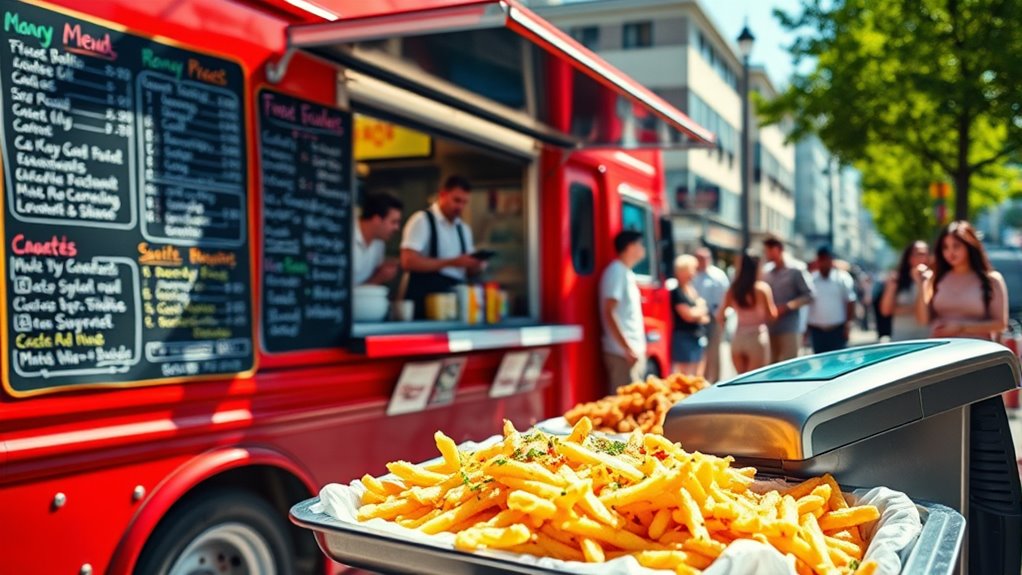Understanding profit margins in the food truck industry helps you gauge how much you can earn. Usually, profit margins range from 6% to 8%, with successful trucks reaching 14% to 15%. Key costs include food, labor, fuel, and overhead. To improve your profits, focus on controlling ingredient costs, optimizing staff schedules, and offering appealing menu options. If you want to uncover more tips and strategies, stay with us to learn how to boost your food truck’s profitability.
Key Takeaways
- Food truck profit margins typically range from 6% to 8%, with top performers reaching 14-15%.
- Major costs impacting margins include food ingredients (25-35%), labor (20-30%), and overhead expenses.
- Simplifying menus and controlling waste help maintain ingredient costs below 30%, boosting profitability.
- Utilizing technology like AI, online ordering, and marketing strategies can increase revenue and profit margins.
- Industry averages show net profits between $46,000 and $180,000 annually, depending on efficiency and sales volume.
Typical Profit Margins and Industry Averages
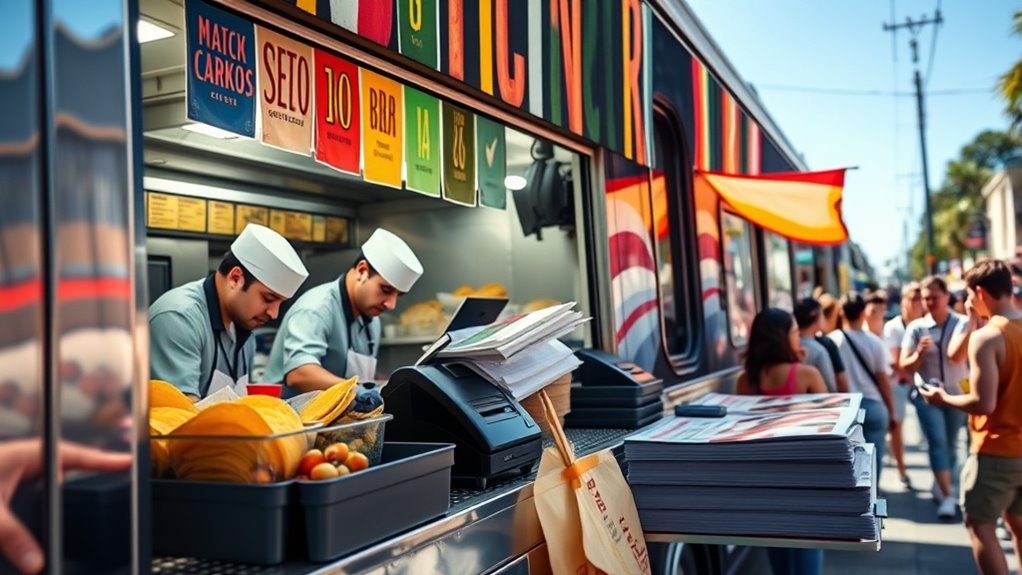
The food truck industry generally sees profit margins between 6% and 8%, with some reports highlighting an average around 6.2%. This range reflects the lower overhead costs compared to traditional restaurants, allowing food trucks to maintain higher profitability. In fact, highly successful trucks can reach profit margins as high as 14% to 15%, demonstrating the potential for strong profits under excellent conditions. Compared to brick-and-mortar eateries, which typically have margins between 1% and 3%, food trucks clearly outperform in this area. In dollar terms, net annual profits often fall between $46,000 and $180,000, depending on revenue and expenses. With average revenues around $290,000 to $364,000, understanding these margins helps you gauge the profitability potential of a food truck business. Additionally, advancements in AI technology are increasingly being used to optimize operations and boost profitability in the industry.
Key Cost Factors Influencing Profitability
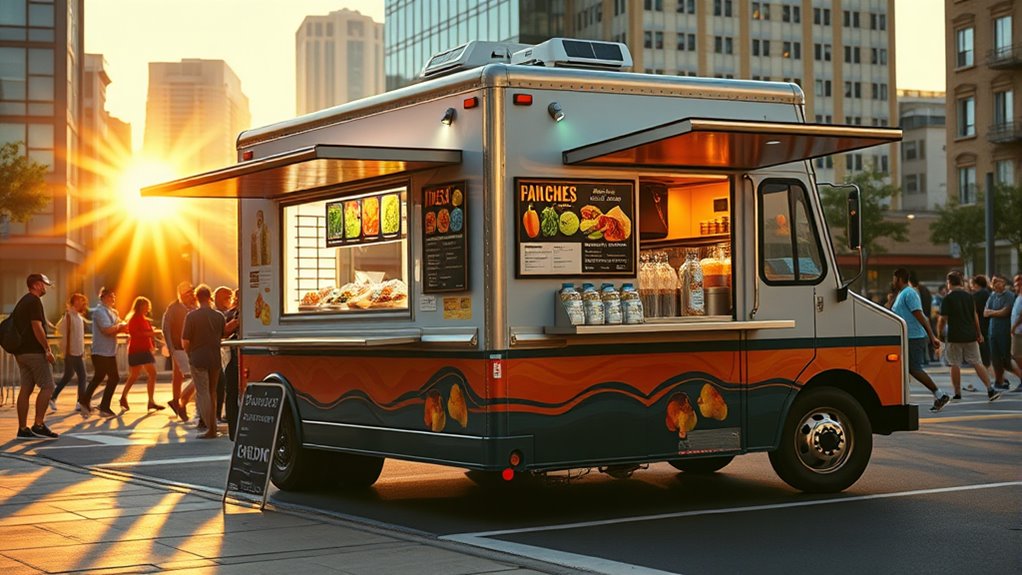
Understanding the key cost factors that influence your food truck’s profitability helps you make smarter operational decisions. Food and supplies costs, which make up 25–35% of revenue, are a significant factor. Opting for simple menus like burgers or tacos can keep ingredient costs lower, boosting margins. Premium ingredients increase COGS and may inflate costs by up to 25%. Labor expenses, accounting for 20–30% of revenue, also impact profit; efficient scheduling and staff management can reduce these costs. Fuel and maintenance costs vary based on truck size and routes; exploring electric conversions could save money long-term. Additionally, energy efficiency improvements in your truck’s systems can lead to lower operational costs over time. Rent, commissary fees, and parking add to overhead, especially in urban areas. Lastly, insurance and compliance costs, though smaller, still affect your bottom line. Managing these factors effectively is key to maintaining healthy profit margins. Effective cost management strategies can significantly enhance your food truck’s profitability.
Strategies to Maximize Revenue and Reduce Expenses
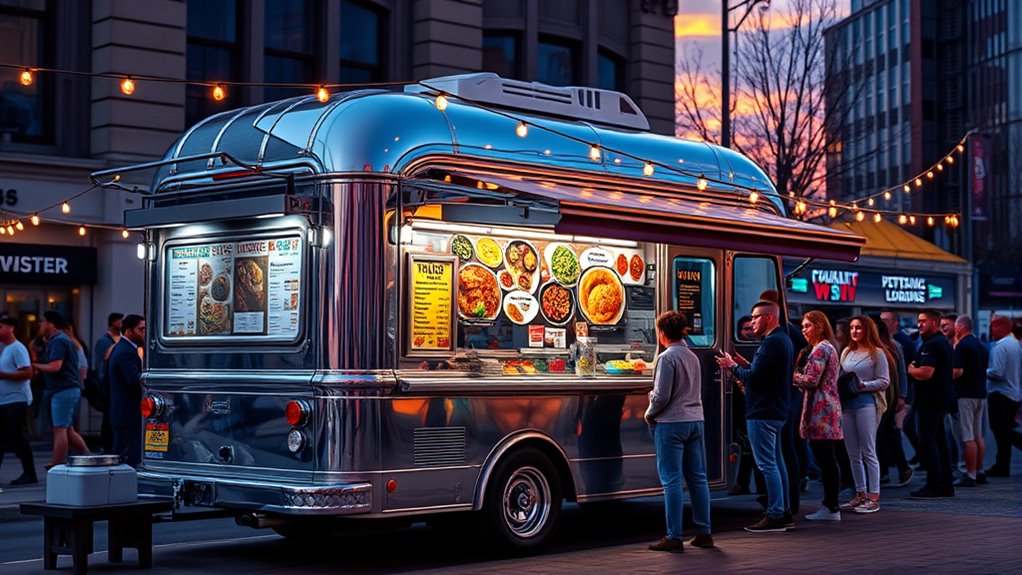
To maximize your food truck’s revenue and reduce expenses, focus on diversifying your offerings and leveraging technology. Expand your menu to include vegetarian, vegan, and gluten-free options, attracting a broader customer base and opening new revenue streams. Introduce seasonal changes, limited-time offers, bundled meals, and happy hour discounts to encourage higher spending and repeat visits. Use customer feedback and sales data to keep your menu relevant and maximize operational hours year-round. Incorporate online ordering and partner with delivery apps to reach more customers. Utilize modern POS systems for better workflow, inventory control, and efficiency. Strengthening your candle making techniques with innovative candle designs and fragrances can inspire novel promotional items or merchandise to attract customers. Utilize social media presence with engaging content and digital promotions. Offering catering and participating in local events can also boost income and brand visibility. Implementing loyalty programs and referral incentives can further enhance customer retention and attract new patrons.
Current Trends and Their Impact on Profitability

Staying ahead in the competitive food truck industry means paying close attention to current trends shaping profitability. Market growth remains strong, with the US industry expected to reach $4.36 billion by 2025, and global growth projected at 6.2% through 2027. This expansion offers more opportunities but also increases competition, as no single company dominates. Eco-friendly practices are gaining traction, with 65% of trucks adopting biodegradable packaging and 40% sourcing locally, reducing costs and appealing to eco-conscious customers. Biodegradable packaging usage is projected to reach 75% by 2025, which further emphasizes the shift toward sustainability. Technology integration, like AI ordering and contactless payments, boosts efficiency and sales—sometimes by 50%. Plus, evolving consumer preferences for plant-based, ethnic, and premium options expand your customer base. Incorporating dog-friendly menu items can attract pet owners and increase foot traffic, as many customers seek inclusive experiences. Partnering with corporations and capitalizing on events can considerably increase steady, profitable revenue streams.
Techniques to Enhance Profit Margins and Owner Earnings
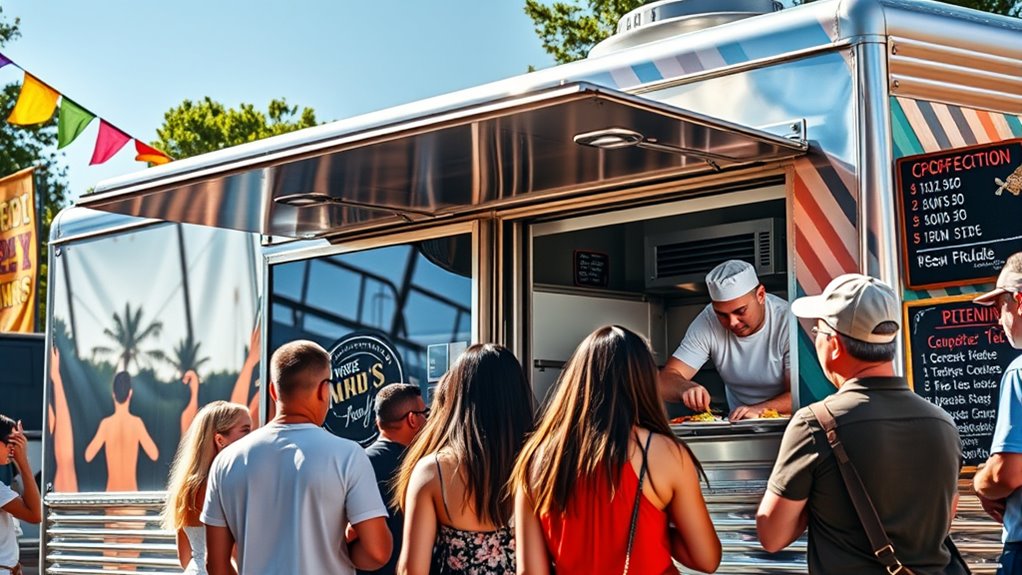
Enhancing profit margins and owner earnings requires strategic focus on controlling costs, optimizing pricing, and streamlining operations. You can reduce food and beverage costs by aiming for ingredient costs below 30% and buying in bulk. Minimize waste through precise portion control and effective inventory management. Parking on owned property cuts fixed costs, while hiring experienced staff boosts efficiency and lowers training expenses. Adjust your menu prices based on ingredient costs and competition, focusing on high-margin, popular items. Simplify your menu and include seasonal or local ingredients to cut costs and attract customers. Offering combos or add-ons increases transaction value without significant extra costs. Participating in events, partnering with local businesses, and leveraging social media grow your customer base and sales, directly boosting your profit margins. Additionally, inventory management can be optimized to prevent overstocking and reduce spoilage, further increasing profitability.
Frequently Asked Questions
How Does Location Influence a Food Truck’S Profit Margin?
You might wonder how location impacts your food truck’s profit margin. It’s simple: a prime spot with high foot traffic can boost sales and help cover higher permit and parking costs. But, if you choose a poor location, your sales suffer, making it harder to cover expenses and squeeze out profits. Strategic placement balances high sales volume against increased costs, ultimately maximizing your profit margin.
What Impact Does Menu Complexity Have on Profitability?
You should know that menu complexity directly impacts your profitability. A complicated menu with many ingredients raises food costs and makes inventory management harder, which can lower your profit margins. It also requires more skilled labor and longer prep times, increasing operational costs. On the other hand, simpler menus help you control costs, speed up service, and boost margins, making your truck more efficient and profitable overall.
How Can Seasonal Variations Affect Food Truck Earnings?
Seasonal variations markedly impact your food truck earnings. During spring and summer, you’ll see increased customer foot traffic, boosting revenue by up to 30%. In contrast, colder months can cut sales by 40-50%, reducing daily income. To adapt, you should modify your menu, shift locations, and promote seasonal specials. Partnering with events and diversifying your offerings can help you maintain steady earnings year-round despite these seasonal fluctuations.
What Role Does Branding Play in Increasing Profit Margins?
Ever wondered how branding boosts your profit margins? Strong branding makes your food truck more visible and memorable, encouraging loyalty and repeat business. It lets you command higher prices and target niche markets, increasing your average sales. Additionally, consistent branding streamlines operations and marketing, reducing costs. By expanding your brand’s reach through merchandise, catering, or collaborations, you open new revenue streams that notably improve your profit margins.
How Do Licensing and Permit Costs Impact Overall Profitability?
Licensing and permit costs substantially impact your food truck’s profitability. High fees, especially in cities like Boston or California, cut into your profit margins and reduce cash flow for marketing or equipment upgrades. Ongoing permit renewals add fixed expenses, making it harder to maintain healthy profits. Lower-cost locations, like Indiana, offer better margins, so choosing your city wisely can help you maximize earnings and keep costs manageable.
Conclusion
Understanding profit margins in the food truck industry is vital for your success. Did you know that the average profit margin ranges from 6% to 9%, but some top performers reach up to 15%? By carefully managing costs, embracing current trends, and applying proven strategies, you can boost your earnings. Keep optimizing your operations, and you’ll increase your chances of thriving in this competitive industry. Your profit potential is within your control—so take action today!
